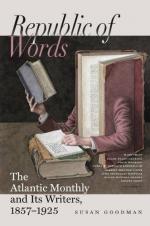and Songs” nine short extracts from other poems
of Wither are quoted, and in these we have found no
less than seven misprints or false readings which
materially affect the sense. Textual inaccuracy
is a grave fault in the new edition of an old poet;
and Mr. Farr is not only liable to this charge, but
also to that of making blundering misstatements which
are calculated to mislead the careless or uncritical
reader. Infected by the absurd cant which has
been prevalent for the last dozen years among literary
sciolists, he says,—“The language
used by Wither in all his various works—whether
secular or sacred—is pure Saxon.”
Taken literally, this assertion is manifestly ridiculous,
and, allowing it every possible limitation, it is
not only untrue of Wither, but of every English poet,
from Chaucer down. The translators of our Bible
made use of the German version, and a poet versifying
the English Scriptures would therefore be likely to
use more words of Teutonic origin than in his original
compositions. But no English poet can write English
poetry except in English,—that is, in that
compound of Teutonic and Romanic which derives its
heartiness and strength from the one and its canorous
elegance from the other. The Saxon language does
not sing, and, though its tough mortar serve to hold
together the less compact Latin words, porous with
vowels, it is to the Latin that our verse owes majesty,
harmony, variety, and the capacity for rhyme.
A quotation of six lines from Wither ends at the top
of the very page on which Mr. Parr lays down his extraordinary
dictum, and we will let this answer him, Italicizing
the words of Romanic derivation:—
“Her true beauty leaves behind
Apprehensions in the mind, Of more sweetness
than all art Or inventions can impart;
Thoughts too deep to be expressed, And
too strong to be suppressed.”
But space fails us, and we shall take up the editions
of Marston and Webster in a future article.
Galleries and Cabinets of Art in Great Britain,
etc. By DR. WAAGEN. Forming a Supplemental
Volume to the “Treasures of Art in Great Britain.”
8vo. London. 1857.
The Manchester Exhibition, although containing a vast
number of works of Art, displayed but a small portion
of the treasures of painting and sculpture scattered
through Great Britain, in the city and country houses
of the upper classes. Every year is adding greatly
to the number and value of both private and public
galleries in England. It is but three years since
Dr. Waagen published his three ponderous volumes on
the “Treasures of Art in Great Britain,”
and he has already found new material for a fourth,
not less cumbrous than its predecessors. The
larger part of this last volume is, indeed, composed
of descriptions of galleries existing at the time
of the publication of his first work, but the most
interesting portion of it relates to the acquisitions
that have been made within the last three years.




